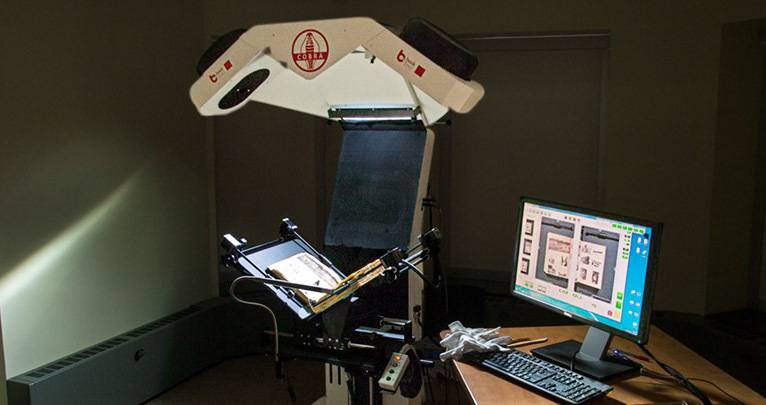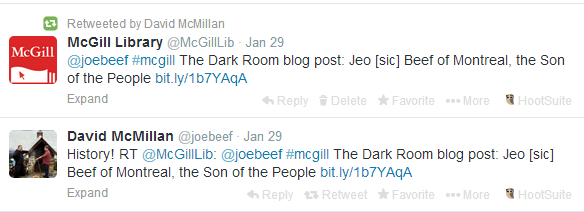
The Cobra rare book scanner has a v-shaped book cradle that protects the spine of a book by limiting the pressure put on the bindings. Two cameras mounted from above capture two pages at a time with minimum page curl. Capturing the image from above rather than on a flat bed scanner results in a sharper image and allows for minimal handling. Credit: Klaus Fiedler, McGill Library
Digitization is changing how students, academics and the general public interact with materials stored in the McGill Library. About 25% of these rare holdings are unique items that deserve to made more accessible to a wider audience.
McGill is now scaling up these digitization efforts and has bolstered its expertise in this area, through the recent hiring of Jenn Riley, Associate Dean, Digitization Initiatives, and Sarah Severson, MLIS’09, its first Digitization and Preservation Librarian.
DAR Communications recently sat down with Jenn and Sarah to discuss how digitization is transforming the way that McGill’s literary treasures are accessed and viewed by scholars from all over the world.
DAR Communications (DC): Why is McGill putting increased emphasis on digitization?
Jenn Riley (JR): Many of the Library’s holdings – especially those in the rare and special collections – are fragile and must be handled with the utmost care. Digitization offers the Library exciting new opportunities for sharing knowledge, and for preserving and housing rare and special items that ensure their conservation and their wide availability to students and scholars within McGill and around the world.
But now, thanks to high-tech digitization tools, it is possible to create preservation-quality digital copies that scholars at McGill and around the world can access and interact with. This has enhanced the relevance of the McGill Library and increased awareness of its many unique treasures. Now that we have established a solid base of expertise in digitization, we are eager to take things to the next level.
DC: Please explain how the digitization process works.
Sarah Severson (SS): Digitization is not just about transforming the analogue into the digital, it’s a really collaborative process. The first step is working with various liaison librarians across campus to select appropriate material. Then we work with the Collection Services team to ensure the best descriptive information is captured for each item. Once the digitization process is complete, the web services team then takes the reigns and makes sure the material is accessible and findable on the web, be it through a custom exhibition website or through our catalogue .
Most of our digitization is done on site, using one of our six specialized machines. We have one set up that has the capacity to capture the smallest of details in one of the rare chapbooks that measures just 18cm. Then on the other extreme we have an overhead medium format system that can capture an image measuring up to 12000 x 15990 pixels. To give you an idea of how big that is, we could digitize an architectural drawing and then print in full quality so large you could walk right into the scene.
Among the recently completed projects was the digitization of all McGill Yearbooks. This was a massive undertaking that involved scanning and cataloguing of all of the volumes from 1898 to 2000. After scanning, each book also went through a process called optical character recognition to make sure all of the text in each book was completely searchable. Type in a famous name and sometimes you’ll be surprised to see what club or organization the person was a part of.
We come across so many interesting things while digitizing. So much so that the team started up a blog called The Dark Room so we can share what we find. Sometimes the plainest book cover can hide some really beautiful illustrations.
DC: With so many items in its collection, how does the McGill Library decide which ones to digitize?
JR: McGill is fortunate to house materials in its Library that are extraordinarily unique and rare, ranging from original works by Galileo to peerless collections of near Eastern, Asian and Islamic materials, to centuries-old fur-trading maps from Quebec’s early days. In fact, fully 25% of the Library’s holdings are highly unusual, and it is the digitization of these uniquely valuable materials that is currently the focus of our efforts.
To date, more than 50 digital exhibitions and collections have been completed, covering a wide array of subjects including, art, architecture, history and literature, engineering, medicine, maps, music, and urban design.
There are many more items which the Library is eager to transfer to a digital medium. These include materials from McGill’s Archives and other rare and important items from across the University.
DC: The digitization of the Libraries’ collections must be very exciting for scholars.
SS: Yes, digitization has been a real game-changer. But scholars are not the only ones who have benefitted. We can now get things out into the public domain that most people had no idea existed. Now, material that was previously only accessible to serious investigators visiting the Library can be viewed and enjoyed worldwide.
We are also discovering that, thanks to social media, an obscure object can be viewed by a larger audience than we ever imagined. Several months ago, we posted on our blog about the digitized version of the original manifesto issued by “Joe Beef of Montreal, the Son of the People”. It was put out in 1879 by Charles McKiernan, nicknamed Joe Beef, the proprietor of Joe Beef’s Canteen in Montreal, at a time when he was defending himself against a campaign to discredit him, led by a local businessman who deplored the sale of alcohol at the Canteen.
DC: What’s next for digitization at McGill?
JR: We have ambitious plans for digitization. But this will require us to hire additional staff and purchase more specialized equipment.
The latest complex digitization scanners can cost between $20,000 and $75,000 apiece. We also need to hire more staff to identify and catalogue materials. In addition, individuals trained in preservation techniques are required to scan rare objects and make them available online.
McGill is already a leader in digitization, management and access to information. With the help of new, cutting-edge equipment, including instant-capture scanners, we will be able to take digitization to the next phase: high quality plus volume.















Leave a Reply
You must be logged in to post a comment.